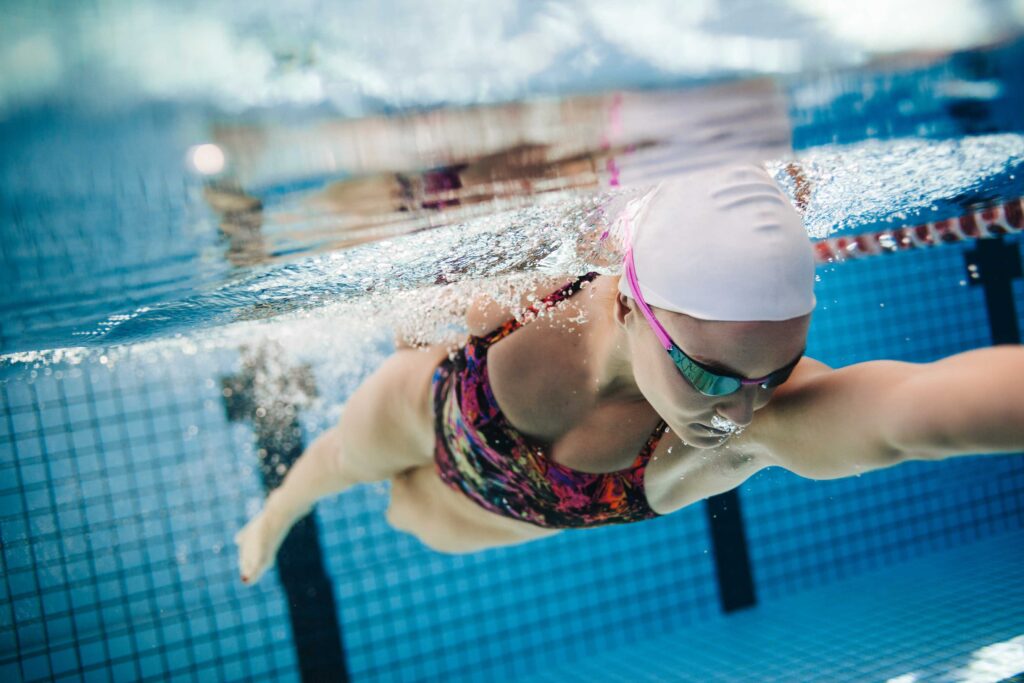Wig-wearing lifestyle has now evolved all these years to the point where you can wear wigs in almost any activity you get yourself into; that includes swimming. While the simplest thing to do is to not wear a wig while swimming and just have a swim cap over your head, it is understandable that some individuals may actually prefer wearing their wig while swimming. This is now especially becoming more common in mermaiding (where women or men dress up as merfolks and swim underwater). Now the different techniques we will enumerate below will vary depending on the level of activity you are going to engage in while swimming. We will also cover the types of wigs used as well as the tools that can help to secure the wig on.
Synthetic VS Natural Human Hair Wig
First of all, we already established that human hair wigs are more expensive than synthetic wigs. So if you’re thinking about using it in the pool, it’s really economically not advisable to do so. Maybe you can wear it while you’re in the pool and try to avoid getting it wet but it’s just too high risk to even attempt it without getting a spray of chlorinated water here and there. Chlorine in the pool has such a bad effect on natural hair that it dries it out and causes it to have split ends. So on the aspect of “can” you wear a human hair wig in the pool, yes you can but it’s not gonna be good after getting even a little wet.
Synthetic wigs are not exactly resistant to chlorinated water but they fare better than natural human hair wigs. They are also cheaper (or at least depending on what synthetic wig you got). Just like our advice on workout wigs, you will want to get a wig that you don’t really worry about damaging while using.

Pool Dip and Light Wading
If you happen to do just a simple pool dip where you won’t find yourself really getting your hair wet, you can follow the style of securing your wig for a workout. Even if a pool dip is not very intense as an activity, you can expect your scalp to get rather sweaty as moving around the pool actually burns calories and this means heat generation that you will experience on your head. Having your wig extra secured will also help so you will feel confident in moving around the water instead of worrying if the wig is getting out of place.
Light Swimming and Submerging of Head
Now if you know you will get your wig wet, then it makes sense to prepare for a wet wig and find all methods to secure it even when wet. When your wig gets wet there are two main things you need to consider: the wig gets heavier and whatever is securing it may give way.
So how do you secure a wig in a wet situation? There have been options for waterproof wig glue but some wig wearers experience slip-offs especially the longer they are in the water. Now this is not to say all waterproof wig glues will fail during a swim but this will also depend on the quality of the wig glue you purchased.
If you don’t feel too good about wearing wig glue, there are other options that are still adhesives but not in the form of a glue. You have wig tapes and wig grips. These are more appropriate for situations where you do go underwater with your wig on.
Wig tapes are double-sided tapes that you put on your head and they secure the wig by sticking to the wig. Now you can have good quality wig tapes but if your wig does not have a good base to secure on this will not work as well as it should. Make sure you select a wig tape that is specifically designed for water use. If you have sensitive skin, you can also consider getting wig tapes with the “hypoallergenic” label on it.
Now if you still do not like anything that acts like an adhesive, the wig grip does the job. Although it doesn’t make your wig stick to your head, it does as its name suggests: it adds a gripping texture that allows the wig to hold on to your head better. They’re rather straightforward: wearing it tightly over your head then wearing your wig over the grip. The material is NOT velcro so removing your wig is also easy. Though do not expect this to work for when you are experiencing heavy current against your wig.
Fast Swimming, Strong Water Current
As mentioned above, the wig grip is now out of the picture for this kind of activity. Your wig tape can still secure your wig, but the quantification of the speed of swimming will be hard to measure for determining when your wig can no longer hold on. Say for example you are swimming breast stroke at a normal pace, then yes your wig can hold on with that wig tape in place. However, in a faster or more aggressive swim like butterfly stroke or freestyle, you might need to start considering wearing a swimming cap.
Now swimming caps are not just limited to wig-wearers. In fact, some pools have policies on wearing swim caps to avoid hair strands getting in the filter. Just make sure you use a swim cap that is designed for longer hair because smaller size swim caps can be too tight and will damage your wig. Larger swim caps will comfortably secure your wig and cover all areas preventing water entry. This is actually good for your wig so it will not get exposed to chlorine.
Wig Care After Swimming
Just remember, even with a swim cap, it is wise to give your wig the proper maintenance after a swim. Conditioning it makes all the difference between a tangled wig and a wig that is still good to use for future swims.
